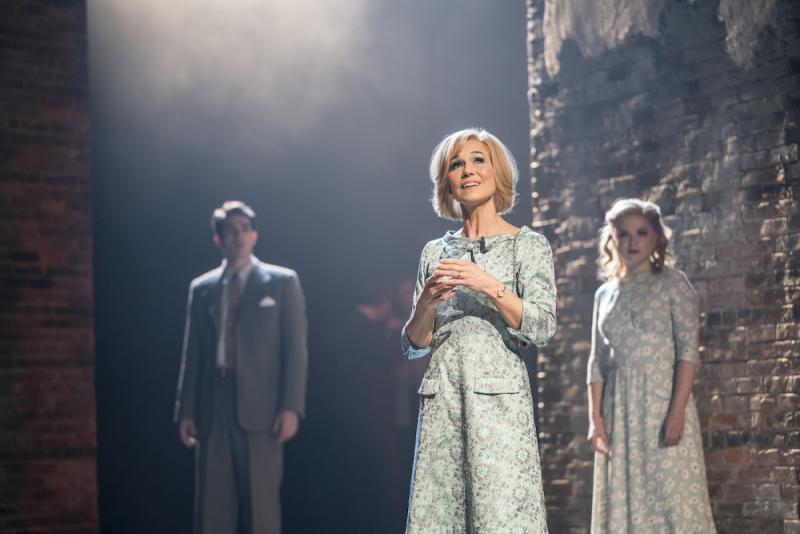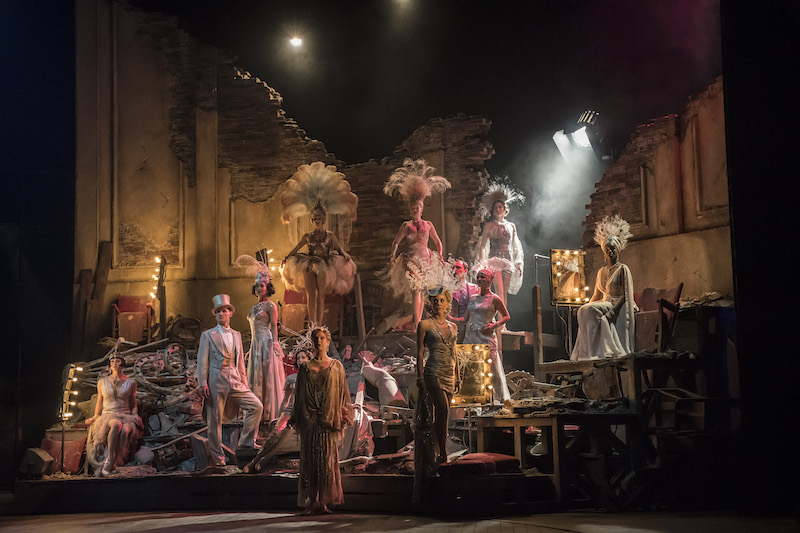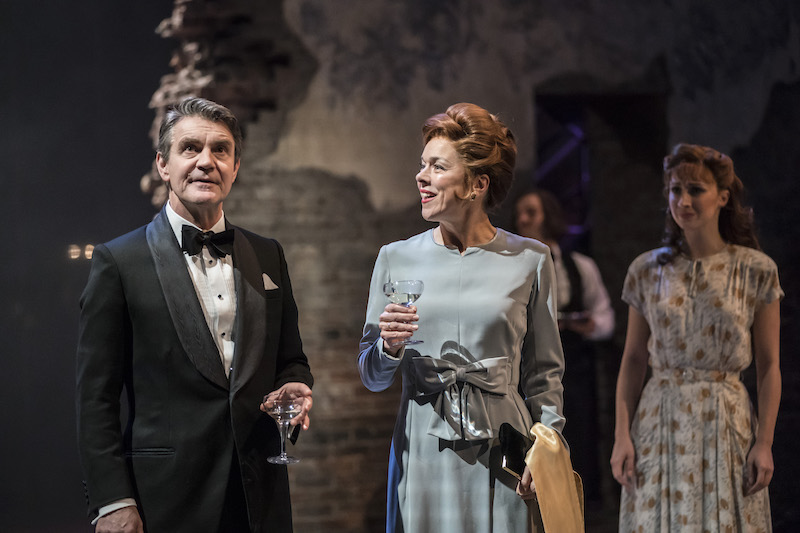Follies, National Theatre review - the Sondheim spectacular returns, better than ever | reviews, news & interviews
Follies, National Theatre review - the Sondheim spectacular returns, better than ever
Follies, National Theatre review - the Sondheim spectacular returns, better than ever
New cast members beautifully complement this definitive production

This is a golden age of London Sondheim revivals, with Marianne Elliott’s thrilling Company still playing in the West End, and Dominic Cooke’s Follies getting a hugely welcome second run at the National – both testament to a director’s transformative vision.
Far more atmospheric than plot-driven, Sondheim and James Goldman’s oft-revised 1971 work has flummoxed many. But Cooke’s version, which returns to the show’s roots, finds endless creative solutions. The Olivier’s revolve shows off Vicki Mortimer's vividly abstracted version of the proscenium arch Weismann Theatre, which, from the start, is haunted by the between-the-wars Follies ghosts (pictured below) – they needing to investigate their future selves, as much as the latter return to the soon-to-be-demolished Weismann to gaze into the past.
The opening sequence is a masterclass of economical storytelling. At this fluidly transitioning reunion party, we immediately get a clear portrait of the Follies girls and their spouses: Sally (Joanna Riding) arrives too early, too invested; Buddy (Peter Forbes) chases after her, masking concern with boisterous bonhomie; Phyllis (Janie Dee) and Ben (Alexander Hanson) are the glamorous power couple, detached from one another; and Carlotta (Tracie Bennett) is the one who “made it” in showbiz, posing for pictures and discarding her wrap in diva-ish fashion.
The sashes emblazoned with their Follies dates (some hidden in embarrassment, one swapped indignantly) immediately clue the audience in, while Cooke’s use of the more expositional speeches as interviews with a documentary crew is inspired. Each choice adds to the prevailing theme of how we view ourselves, past and present, and how we tell the stories of our lives. Seeing the women lining the stairs as Weismann’s “beautiful girls” is at once endearing, funny, triumphant, and achingly poignant.
Described by Sondheim as an “orgy of pastiche”, his period Follies songs reference everyone from Irving Berlin, Cole Porter, Richard Rodgers and Jerome Kern to George Gershwin, Arthur Schwartz and Dorothy Fields – and there are spotlight numbers galore, gorgeously backed by the Nigel Lilley-conducted orchestra. Bennett once again tears the roof off with the roar of defiance that is “I’m Still Here”; Claire Moore gives her a run for her money with a gut-busting “Broadway Baby”; and Geraldine Fitzgerald is a deliciously naughty, self-aware Solange, who now flogs perfume but still takes her pick of chorus boys.
Dawn Hope leads the impeccable mirror number – one of many triumphant contributions from Bill Deamer – with both pizzazz and surprising dredged-up emotions, finishing with tears in her eyes. Gary Raymond brings a hint of nastiness to the formerly despotic Weismann (“I could have had them for a smile,” he says of his “girls” to a creeped-out waitress). Meanwhile, Josephine Barstow, due to return to the show in May, stood in last night for an indisposed Felicity Lott, and her operatic duet with younger self Alison Langer was a shimmering showstopper. As Buddy, Forbes is a magnificent tragic clown – quite literally in his Follies number, which juxtaposes vaudevillian styling with evident heartbreak. And Janie Dee’s Phyllis (pictured above with Hanson) is somehow even more impressive, from the ironic one-liners so brittle they almost snap (akin to Patti LuPone’s Joanne, a role Dee should surely inherit), to the biting fury of “Could I Leave You?” and finally letting loose in her dynamically danced set-piece – a clear demonstration that Phyllis is still there under all that studied cynicism, and she hasn’t yet given up on life.
As Buddy, Forbes is a magnificent tragic clown – quite literally in his Follies number, which juxtaposes vaudevillian styling with evident heartbreak. And Janie Dee’s Phyllis (pictured above with Hanson) is somehow even more impressive, from the ironic one-liners so brittle they almost snap (akin to Patti LuPone’s Joanne, a role Dee should surely inherit), to the biting fury of “Could I Leave You?” and finally letting loose in her dynamically danced set-piece – a clear demonstration that Phyllis is still there under all that studied cynicism, and she hasn’t yet given up on life.
New cast member Alexander Hanson emphasises Ben’s (too) easy charm and weakness; from the start, he’s clumsily self-medicating with booze and women, wearing his success like a straitjacket. He believably grapples with an existential crisis (“The Ben I’ll never be,/Who remembers him?”), yet regresses to frightened boy. But Hanson’s honeyed vocals also demonstrate Ben’s appeal: “Too Many Mornings” has an irresistible yearning.
He’s joined in the latter by Joanna Riding, succeeding Imelda Staunton as Sally. Riding contributes a very different reading of the character – initially sweetly gauche and coy, and, as a nimble mover, able to recall the flirtatious chorine. But “Losing My Mind” becomes a dark revelation of a torch song: the monster emerging from the glamour girl, mascara running, lip curling, venomously pill-popping, savage in her desolation. It’s electrifying.
Playing the main quartet’s younger selves, there’s superb work from Harry Hepple, Christine Tucker, Ian McIntosh and Gemma Sutton – particularly in the intricate Loveland section, heralded by a witty and articulate visual cue from Cooke. Mortimer’s costumes, impeccable throughout, reach their zenith here; Paule Constable’s lighting, too, is crucial in conveying transitions and tone, and sometimes blurring reality and artifice. The Loveland section is the most heightened, yet also the most emotionally revealing, paving the way for a powerful climax. Collaborative art at its very finest: welcome back, Follies.
- Follies at the National Theatre until 11 May
- Read more theatre reviews on theartsdesk
rating
Share this article
The future of Arts Journalism
You can stop theartsdesk.com closing!
We urgently need financing to survive. Our fundraising drive has thus far raised £49,000 but we need to reach £100,000 or we will be forced to close. Please contribute here: https://gofund.me/c3f6033d
And if you can forward this information to anyone who might assist, we’d be grateful.

Subscribe to theartsdesk.com
Thank you for continuing to read our work on theartsdesk.com. For unlimited access to every article in its entirety, including our archive of more than 15,000 pieces, we're asking for £5 per month or £40 per year. We feel it's a very good deal, and hope you do too.
To take a subscription now simply click here.
And if you're looking for that extra gift for a friend or family member, why not treat them to a theartsdesk.com gift subscription?
more Theatre
 Ghost Stories, Peacock Theatre review - spirited staging but short on scares
Impressive spectacle saves an ageing show in an unsuitable venue
Ghost Stories, Peacock Theatre review - spirited staging but short on scares
Impressive spectacle saves an ageing show in an unsuitable venue
 Hamlet, National Theatre review - turning tragedy to comedy is no joke
Hiran Abeyeskera’s childlike prince falls flat in a mixed production
Hamlet, National Theatre review - turning tragedy to comedy is no joke
Hiran Abeyeskera’s childlike prince falls flat in a mixed production
 Rohtko, Barbican review - postmodern meditation on fake and authentic art is less than the sum of its parts
Łukasz Twarkowski's production dazzles without illuminating
Rohtko, Barbican review - postmodern meditation on fake and authentic art is less than the sum of its parts
Łukasz Twarkowski's production dazzles without illuminating
 Lee, Park Theatre review - Lee Krasner looks back on her life as an artist
Informative and interesting, the play's format limits its potential
Lee, Park Theatre review - Lee Krasner looks back on her life as an artist
Informative and interesting, the play's format limits its potential
 Measure for Measure, RSC, Stratford review - 'problem play' has no problem with relevance
Shakespeare, in this adaptation, is at his most perceptive
Measure for Measure, RSC, Stratford review - 'problem play' has no problem with relevance
Shakespeare, in this adaptation, is at his most perceptive
 The Importance of Being Earnest, Noël Coward Theatre review - dazzling and delightful queer fest
West End transfer of National Theatre hit stars Stephen Fry and Olly Alexander
The Importance of Being Earnest, Noël Coward Theatre review - dazzling and delightful queer fest
West End transfer of National Theatre hit stars Stephen Fry and Olly Alexander
 Get Down Tonight, Charing Cross Theatre review - glitz and hits from the 70s
If you love the songs of KC and the Sunshine Band, Please Do Go!
Get Down Tonight, Charing Cross Theatre review - glitz and hits from the 70s
If you love the songs of KC and the Sunshine Band, Please Do Go!
 Punch, Apollo Theatre review - powerful play about the strength of redemption
James Graham's play transfixes the audience at every stage
Punch, Apollo Theatre review - powerful play about the strength of redemption
James Graham's play transfixes the audience at every stage
 The Billionaire Inside Your Head, Hampstead Theatre review - a map of a man with OCD
Will Lord's promising debut burdens a fine cast with too much dialogue
The Billionaire Inside Your Head, Hampstead Theatre review - a map of a man with OCD
Will Lord's promising debut burdens a fine cast with too much dialogue
 50 First Dates: The Musical, The Other Palace review - romcom turned musical
Date movie about repeating dates inspires date musical
50 First Dates: The Musical, The Other Palace review - romcom turned musical
Date movie about repeating dates inspires date musical

Add comment